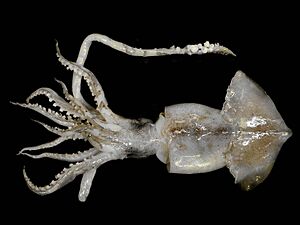Lesser flying squid facts for kids
Quick facts for kids Lesser flying squid |
|
|---|---|
 |
|
| Conservation status | |
| Scientific classification | |
| Synonyms | |
|
The Todaropsis eblanae, also known as the lesser flying squid, is a type of short-finned squid. It belongs to a special group called Todaropsis, which is part of the Ommastrephidae family.
Contents
About the Lesser Flying Squid
This squid is fairly small, usually growing to be about 13 to 22 centimeters (around 5 to 9 inches) long. It has a big, wide head. Male squids can reach a maximum mantle length (the main body part) of 16 cm, while females can grow up to 27 cm.
The lesser flying squid has a fin at the end of its body that looks like a wide diamond shape. It's wider than it is long and rounded at the back. Its arms are strong and more than twice as long as its head. The special "club" part of its tentacles is thin and has four rows of suckers. These suckers don't extend far down the tentacle stalk.
Where They Live (Habitat)
You can usually find these squids living near the bottom of the ocean, especially in muddy areas.
What They Eat (Biology)
Scientists have studied what the lesser flying squid eats by looking at specimens caught near Galicia in Spain. They found that these squids eat three main types of food:
- Bony fish
- Crustaceans (like crabs and shrimp)
- Other cephalopods (like other squids or octopuses)
Their favorite food seems to be the blue whiting fish (Micromesistius poutassou). This fish makes up about 43% of what they eat! In waters near Ireland, another small fish called Mueller's Pearlside (Maurolicus muelleri) is also a very important meal for them. It was found in over 34% of the squid stomachs that had food in them.
Life Cycle and Reproduction
In the northern parts of the ocean, lesser flying squids usually mate and lay their eggs during the summer and early autumn, from June to November. The eggs then hatch later in the autumn and early spring, from October to March. This means that young squids are born during the first half of the year.
Where They Are Found (Distribution)
The lesser flying squid lives in many different parts of the world's oceans. You can find them in the eastern coastal waters of the North Atlantic and South Atlantic, all the way from Shetland (north of Scotland) down to the Cape of Good Hope in South Africa. They also live in the Indian Ocean, along the coasts of southern Africa, Madagascar, and the Mascarenes. Further east, they are found north to the Timor Sea and along the western and southeastern coasts of Australia.
Squid Fishing (Fisheries)
Even though the lesser flying squid is one of the most common squids in the Celtic Sea (an area of the Atlantic Ocean), it's usually caught by accident. Fishermen often catch them as "bycatch" while they are trying to catch other types of fish.



